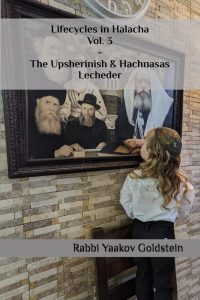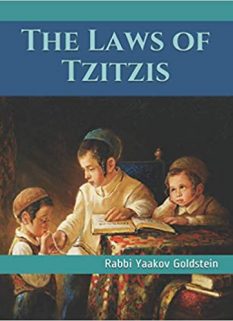
Hachnasas Lacheder- Introduction & Checklist
| Introduction:
One of the great milestones for a parent and child is the formal start of the child’s education in a Talmud Torah, where he will learn Torah and Mitzvos. The induction of the child into the Torah academy is escorted with various customs and ceremonial practices that are done to ensure the purity of the child and help penetrate within him an initial love of Hashem and Torah, and lead him to become a G-d fearing Jew who is educated in Torah knowledge. Throughout the generations, this practice was kept with special excitement and fervor, and various detailed practices have been recorded, as will be brought in this section. The ceremony which is performed on the day of the child’s entrance into a Torah academy is customarily referred to in Yiddish as the Areinfirinish, and in Hebrew as Hachnasas Lecheder. |
Hachnasas Lecheder Checklist
Items to bring on the day of Hachnasas Lecheder:- Tallis
- Cake cooked in oil with pesukim
- Shelled egg with pesukim
- Honey for the Alef beis
- Toothpick
- Peckalach for classmates
- Laminated Tanya sheet
- Candies to be thrown
- Camera
- Tzedaka
- Wine for Lechayim
- When: It is customary to perform the Hachnasas Lacheder ceremony on the third birthday, or shortly after.
- Morning: The father and son are to awaken early on the day of the Hachanasa Lecheder ceremony in order to perform it early in the morning.
- Bathing and Dressing the child: For the occasion of the ceremony, the child is to be bathed and dressed in clean and elegant clothing [i.e. Shabbos clothing].
- Bringing child to Cheder covered in a Tallis: In the morning, the takes his child to the cheder wrapped in a Tallis in a way that he cannot see or be seen. He is to be careful not to see a non-Kosher animal or gentile or even insect. After entering the cheder, the child is taken out from the Tallis and it is then draped around his shoulders.
- Teacher teaches him Alef from Tanya: The teacher seats the child on his lap and begins teaching him the Alef Beis. It is customary in Chabad to begin with the Alef from [a laminated] title-page [i.e. Daf Hashaar] of the Tanya [which has the letter Alef coated with honey, as explained next]. The teacher points to the letter, says Alef, and the child repeats Alef.
- Teacher teaches him rest of letters forwards and backwards: Afterwards, the teacher reads the Alef-Beis letter after letter for the child, pointing to the letters and having the child repeat after him. It is to be read in order. He then reads the letters in reverse order Taf-Shin-Reish, with the child repeating. Some are accustomed when reading the letters backwards to the child to read each letter individually starting from Taf. Others, however, are accustomed to read it in abbreviations as Tashrak, Tzapas, Nimlach, Yatchaz, Vehadag, Bo [תשרק צפעס נמלך יטחז והדג בא]. One is to also teach the child the end letters of Manatzpach, which is the Langa Mem, Langa Nun, Langa Tzadik, Langa Pei and Langa Chafםןץףך .
- Licking honey off the letters: After having taught the child the letters of the Alef Beis, using a toothpick and the like, the teacher coats the letters with honey [on a laminated Alef Beis sheet]. The child recites the blessing Shehakol and then licks the honey off the letters.
- Teaching Nekudos forwards and backwards: He then teaches the child each of the Nekudos (vowels), reading them in order [and then in reverse order] with the child repeating after him.
- Saying Torah Tziva: The teacher then recites – and the child repeats – the verse: Torah Tzivah Lanu Moshe Morasha Kehilas Yaakov, and the request “Torah Tehai Emunosi Ve-Eil Shadai Be’ezras.”
- Teaching him Chumash Vayikra: The teacher then takes a Chumash Vayikra and reads the first verse of “Vayikra El Moshe Vayidaber Hashem Eilav Meiohel Moed Lamor” to the child. The child should repeat after the teacher word after word. Some also read the second verse to the child. Some are accustomed to read to the child and to learn with him the entire first paragraph.
- Birchas Kohanim: Some are accustomed to blessing the child with Birchas Kohanim by the Hachnasas Lacheder ceremony.
- Throwing candies and coins on child from Malach Michael: Candies and coins are to be thrown upon the child as he reads the Alef Beis and he is to be told that they were thrown by the Angel Michoel.
- The honey cake with inscribed words: The parents give the teacher a honey cake [i.e. cake kneaded with honey] onto which certain verses are inscribed. On the cake the following words are to be inscribed [see below for the Hebrew]: 1) Adonoiy [write Hashem with a Hei] Elokim [i.e. Havaya in original, but write Elokim as is read] Nasan Li Lashon Limudim Ladas Laus Es Yaeif Davar Yair Babaoker Babaoker Yair Li Ozen Lishmoa Kilimudim. 2) Adonoiy [write Hashem] Elokim [i.e. Havaya in original, but write Elokim] Pesach Li Ozen Veanochi Lo Marisi Achur Lo Nesugosiay. The names of Hashem that are in these verses should not be written out fully due to the prohibition against erasing them, and rather one should either abbreviate the name such as writing Hei instead of Yud Kei Vav Kei, and writing Elokim with a Kuf instead of with a Hei. Likewise, Adonoiy should be written as Hashem, with a Hei. The teacher reads the verses and the child repeats after him word for word. The teacher then gives a piece of the cake to the boy, who eats it after reciting the blessing Borei Minei Mezonos together with the teacher. Eating the cake is a Segula for the child to have an open heart for Torah study. The cake should be cut in a way that the letters remain whole, and the child should be given a full piece that contains a letter so that the child consumes the holy letters of Scripture.
- Shelled egg with writing of scripture is read and eaten: An egg is to be cooked, hardboiled, and then peeled onto which certain verses are to be inscribed on. The teacher reads the verse and the child repeats after him word for word. The child then eats the egg after saying the blessing of Shehakol together with the teacher [if he has yet to say it over the honey].
- The following verse is to be written on the egg: ויאמר אלי בן אדם בטנך תאכל ומעיך תמלא את המגלה הזיאת אשר אני נתן אליך ואכלה ותהי בפי כדבש למתוק
- Sefer Torah: The child should be stood near a printed Torah scroll in the Cheder during the ceremony. A kosher Torah scroll is not to be brought for the occasion.
- Giving Tzedaka: The child is to be given coins to distribute to charity during the occasion. Coins are also to be distributed to the fellow classmates of the child for them to personally give to charity in merit of the child. A charity box should be brought to the classroom for this purpose. Likewise, the parents are to give charity on this day.
- Paying the Milamed: It is proper for the father to give money to the Milameid, who is the teacher who is performing the ceremony of the Hachansas Lecheder.
- Distributing bags of candy: Customarily, the child distributes bags of candies to the other children by the Hachansas Lecheder.
- Distributing Lechaim, and Mezonos: At the conclusion of the ceremony the parents are to distribute Lechaim, and Mezonos to those gathered. Those present bless the parents that they merit to bring the child to Torah, Chuppah, and good deeds.
- Bringing the child back home: Upon returning the child back home, the child is to be covered in a Tallis just as he was covered when he was brought to the Cheder [and that he should remain sheltered throughout the day from seeing any impure item]. Some however are not particular in this matter.
- Feast: In the evening, it is customary for the family to hold a celebratory feast in honor of the Hachansas Lecheder. This meal is considered a Seudas Mitzvah.
- Bringing child to river: Some are accustomed to bringing the child to the banks of a river after the conclusion of the ceremony, as the Torah is compared to water, and doing so is a Segula for the child to have a wide understanding of Torah
[1] Sources which mention the Minhag of Hachnasas Lecheder:
Rishonim: Machzor Vitri 508; Rokeiach 296; Orchos Chaim 2:3; Kol Bo 74; Seder Chinuch Hayiladim of Rabbeinu Efraim Mibuna; Seder Chinuch Hayeladim Sefer Hasufos 282;
Achronim: Admur Hilchos Talmud Torah 1:1; Michaber and Rama Y.D. 245:8; Shach Y.D. 245:8; Yesod Yosef 69; Kav Hayashar chapter 72; Chok Yaakov 494:1; Elya Raba 494:3; Migdal Oz Birchas Givon Taaleh 1; Arugas Habosem 210; Afrasakta Deanya 161; Mishpat Tzedek on Tehillim p. 85;
Chabad: Sefer Hasichos 5700 p. 67; Sefer Hasichos 5701:29; Sefer Hasichos 5701 p. 65; Sefer Hasichos 5704 p. 47; Sefer Hamamrim 5711 p. 168; Igros Kodesh 3:407; 6:120; 7:55; 12:288; 14:39; Likkutei Sichos 5:86 footnote 4; Sichos Kodesh 5752 1 p. 343; Heichal Menachem 3:247; Shulchan Menachem 5:34; Yagdil Torah Yerushalayim 26:11; Hearos Ubiurim Ohalei Torah 1019 p. 44; Hiskashrus 874 p. 15; 904 p. 13
Melaktim: Shevach Habris; Nitei Gavriel



Leave A Comment?
You must be logged in to post a comment.